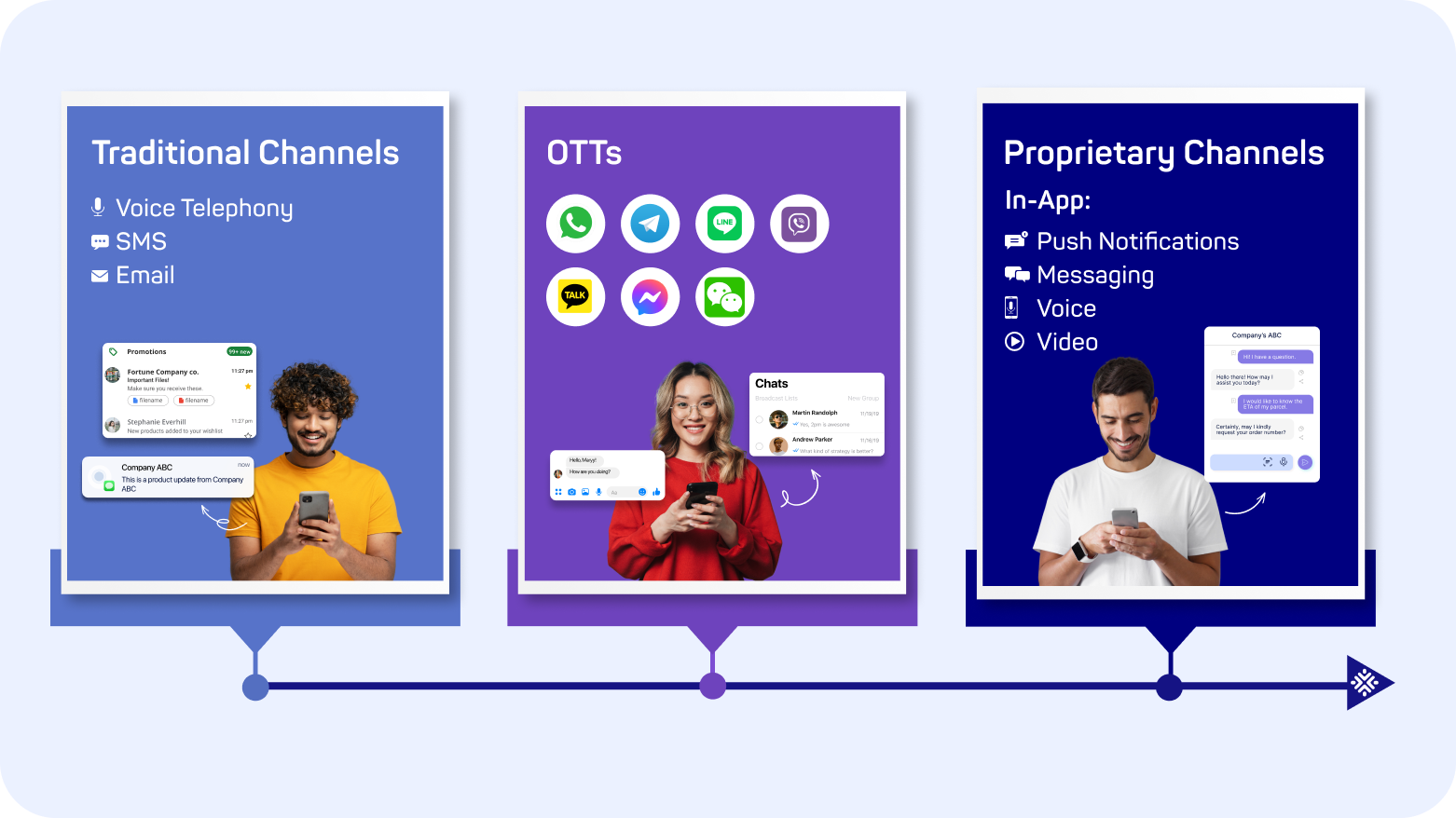Ranked 225th among the Top 500 High-Growth Companies in APAC in 2024 by the Financial Times and Statista, Toku strengthens its position as the leading customer experience enabler for medium and large enterprises in the region.
As we usher in the Lunar New Year, the pace of technological innovation does not pause, continuing to redefine the landscape of cloud communications and customer engagement.
In this time of renewal and reflection, it’s more important than ever for businesses, especially those in the APAC region, to anticipate and adapt to the emerging trends that promise to reshape standards of customer experience and operational efficiency.
From the evolving landscape of data privacy regulations to the seamless integration of AI-driven customer service solutions, the upcoming year presents a blend of challenges and opportunities.
This article unveils Toku’s 10 expected CX trends for the coming twelve months, illuminating the future where customer engagement, technology, and strategic business outcomes intersect. Each trend spotlights a shift in the industry, emphasising the critical role of adaptability, innovation, and customer-centricity in steering the course ahead.
1. Data Privacy in Focus: Navigating Regulatory Compliance
AI and machine learning technologies are rapidly becoming integral to the operational fabric of businesses, bringing the issue of customer data privacy into sharper focus. The imminent ramp-up in regulatory enforcement concerning data processing and storage mandates enterprises to not only align with stringent standards but also to revisit and refine their RFP and tender processes. This strategic adjustment is vital for challenging software providers on their data handling practices, ensuring compliance, bolstering customer trust, and navigating the complexities of an increasingly scrutinised digital landscape.
2. The Omnichannel Evolution: Crafting Seamless Communications
As the digital communication landscape transitions from traditional telephony to Over-The-Top (OTT) platforms and proprietary in-app channels, businesses face a pivotal shift in customer engagement strategies. This evolution demands the adoption of genuine omnichannel deployments that are not just fully integrated with customer data but also infused with stringent checks and balances. Such a holistic approach ensures a seamless and consistent communication journey across all touchpoints, eliminating the need for customers to repeat themselves or compromise their personal information at multiple junctures. By prioritising a security-centric customer experience, businesses can offer unparalleled convenience and personalisation, reinforcing trust and loyalty in a digitally connected world.

3. Hybrid Cloud: The Backbone of Regional and Global Operations
As businesses navigate the complexities of regional and global markets, the imperative for hybrid cloud deployment capabilities becomes increasingly pronounced. This trend is not just about achieving agility, scalability, and security; it’s fundamentally driven by the necessity for multinational operations to adapt to a diverse regulatory landscape. With neither commercial nor private cloud providers able to cover every market comprehensively, the move towards hybrid cloud architectures is essential for enterprise software providers. This approach ensures that businesses can maintain compliance with telecommunications and customer data regulations across different jurisdictions, while also supporting global expansion and ensuring technological resilience.

4. A More Holistic Technology Stack: The Future of CX Solutions
This year marks a pivotal moment in the evolution of customer experience technologies, as we observe the merging of Contact Centres, Customer Engagement Centres, and Digital Customer Service technologies into unified Customer Experience as a Service platforms. This transformation goes beyond merely streamlining communications; it represents a strategic shift towards creating a holistic technology stack capable of supporting diverse use cases across different departments within a single organisation. Sales, marketing, and customer service teams can now leverage the same platform, tailored to their unique needs yet interconnected within an integrated ecosystem. This approach enables the coexistence of specialised modules like campaign managers and contact centres under the umbrella of the same CX platform, ensuring seamless, integrated customer interactions across all touchpoints and redefining service excellence for the digital age.
5. Bridging Worlds: Packaged Business Capabilities in Customer Journey Unification
This year, we spotlight the emergence of Packaged Business Capabilities (PBCs) as a pivotal force in seamlessly reconciling data from both physical and digital customer journeys. PBCs offer a modular approach to technology deployment, allowing businesses to implement specific functionalities tailored to unique aspects of customer interactions, whether online or offline. By leveraging these capabilities, organisations can ensure a unified view of the customer experience, enhancing personalisation and insight across every touchpoint. This integration not only fosters a deeper understanding of customer behaviours and preferences but also drives more cohesive and responsive engagement strategies, setting a new standard for holistic customer-centricity in both digital and physical spaces.
6. Catering to Machine Customers: The Rise of AI-Specific Interfaces
As Generative AI becomes more pervasive, the distinction between human and machine customers is becoming increasingly relevant. The trend towards crafting Gen-AI specific knowledge databases and providing dedicated access APIs marks a significant shift in how brands interact with this new customer base. This innovation not only revolutionises the data exchange between systems but also paves the way for more intelligent, autonomous machine customers. By enabling these digital entities to access, interpret, and act upon data through tailored interfaces, brands and software providers are opening new frontiers in AI-driven customer service and business solutions.
7. Precision Power: Small Language Models Take the Lead
The AI landscape is undergoing a pivotal shift from Large Language Models (LLMs) to the rising prominence of streamlined, purpose-built Small Language Models (SLMs). These are offering a blend of efficiency, customisability, and cost-effectiveness that LLMs can’t match. SLMs excel in specific tasks with less computational load, making them ideal for deployment across various platforms, including resource-constrained devices. Beyond their performance advantages, SLMs also reduce the likelihood of generating hallucinations, making them easier to control and more reliable in their outputs. This aspect, along with safeguarding proprietary data and intellectual property, underscores the strategic advantages of SLMs. This evolution towards SLMs reflects a broader move in AI towards sustainable, tailor-made solutions that align more closely with business and consumer needs, marking a new era of technological innovation and application.
8. Beyond Text: 2024 Embraces Multimodal Models
2024 marks a pivotal shift in artificial intelligence from the predominantly text-focused Large Language Models (LLMs) to the expansive capabilities of Large Multimodal Models (LMMs). These advanced models integrate visual, auditory, and additional sensory inputs, enabling AI to interpret and interact with the world in unprecedented ways. This evolution paves the way for breakthroughs in robotics, audio, and video processing, where AI’s ability to perceive and understand its environment mirrors human-like complexity and nuance. The advent of multimodal models signifies a significant leap towards AI systems that offer richer, more intuitive interactions, setting the stage for innovative applications across various sectors.
9. Open-Source Reigns Supreme: AI Democratised
The availability of foundational open-source AI components is fast-tracking the commoditisation of AI, making what was once a niche luxury into a universally accessible tool. This evolution significantly reduces the barriers to advanced AI use, placing a new emphasis on data within the AI ecosystem. Organisations that excel in data custodianship will be able to fully leverage AI, leading to the development of not only innovative but also precisely customised solutions for distinct challenges. Achieving this will necessitate a strategic approach to collecting, curating, and applying customer (experience) data. In this landscape, Strategic Data Management stands to emerge as the paramount competitive advantage.
10. Reframing Value: Prioritising New Metrics in CX Solutions Procurement
The evolution of procurement KPIs from Total Cost of Ownership (TCO) to include productivity and customer satisfaction underscores a transformative shift towards recognising customer service, and by extension customer success, as key revenue drivers rather than mere cost centres. This reorientation highlights the growing recognition of customer experience metrics as vital indicators of business health and success. As companies intensify their efforts to boost customer loyalty, there is a marked increase in investment towards enhancing customer experiences. This trend reflects a strategic pivot to value-driven metrics that champion customer-centric solutions, aiming not just to optimise expenses but to significantly improve business outcomes by elevating the quality of customer interactions and building lasting customer relationships.
Embark with us on this journey through transformative developments, as we set the stage for a Year of the Dragon marked by growth, innovation, and unparalleled customer experiences.
The predictions mentioned above are a collaboration between Girish Dharmaraj (Head of Product), Isuru Rajakaruna (Head of AI), Jonathan Mondon (Head of Enterprise), and myself.
If you want to learn more about how Toku can help you reimagine customer experiences, or if you wish to receive more news about CX, join our newsletter!
 Thomas Laboulle
Thomas Laboulle 


 Ana Castrillon
Ana Castrillon 
 V K Sanjeed
V K Sanjeed 
 Girish Dharmaraj
Girish Dharmaraj